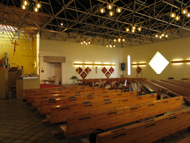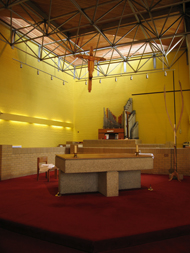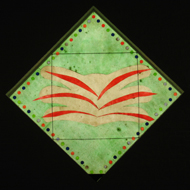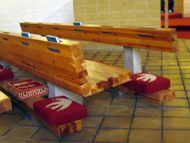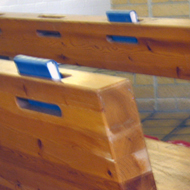Essay
English Religious Architecture of the Sixties
St Francis of Assisi’s Church, Wythenshawe | St Matthew’s Church, Southcote, Reading
St Francis of Assisi’s Church in Wythenshawe stands testimony to the vigour of its first priest, the Reverend Ronald Pitcher.[1] It was Pitcher who organised a local campaign to raise money for its construction, even before William Greer, Lord Bishop of Manchester, launched a wider appeal to fund churches and vicarages in new housing areas throughout the diocese.[2] It was probably also Pitcher who chose the architect, since he made initial contact with Basil Spence late in 1956. Drawings and a watercolour perspective[3] were prepared by the beginning of 1958, when the scheme was priced at £17,500, exclusive of professional fees.[4] Following discussions with the congregation it was modified to provide side-aisles, and the estimate increased to £27,000, including an organ. Although the diocese believed the final cost might be as high as £35,000,[5] the design was accepted and Spence formally commissioned at the end of the year.
The working drawings were prepared in April 1959 by Bob Smart at 1 Canonbury Place.[6] They represented a very rectilinear scheme with few diagonals and no curvaceous elements of any kind, but one which, while simple in its outlines, nevertheless displayed a subtle balance of interlocking compositional elements in its entrance elevation, and in the relationship of that elevation to the detached tower which stood in front of it.
Spence described the site as “a commanding position.”[7] Although the church faced onto Greenbrow Road, being conventionally orientated east/west, it was set back from the pavement, and approached by seven steps rising to a paved open concourse. The entrance elevation derived its principal interest from the manner in which its flat-roofed, double-height main block, expressing the height of the nave behind, was intersected on its left-hand (northern) side by a lower single-storey block containing the chapel, and by the way this was answered on the right-hand (southern) side by another block of similarly low height containing the priest’s and choir vestries. Between these two low blocks was a deep entrance recess, while a large oblong window acknowledged the stair to the choir gallery above the reception foyer. The window was partially concealed by vertical louvres, and through its centre rose the shaft of a large crucifix that broke up well above the roof-line. The nave was structurally separate from this entrance and choir gallery range, being linked to it at its western end only by very tall slim windows, which rose from floor to wallhead. The nave walls were otherwise entirely plain, and therefore simple and economical to construct. At the chancel end, however, the walls were canted inwards. The east gable was also canted at its ends, and between these canted walls side windows answering those at the nave’s western extremity directed light over the altar.
The church was predominantly of cavity brick construction, rising from strip concrete foundations: the external skin was constructed of hand-made light brown facing bricks supplied by Proctor & Lavender of Solihull, and the internal skin of Ellenbrook Commons from the National Coal Board. The stair window louvres were timber, and its crucifix of concrete. The vestry wing was also faced with light brown brick, but the chapel was faced in Portland stone, so emphasising the unusual “Z”-shaped massing of the front elevation at ground floor.
The tower comprised two solid planes of dark brown hand-made facing brickwork, again supplied by Proctor & Lavender, which were joined together at a right-angle to form a “V”-plan structure. It was intended to contrast with the church in both colour and plan-form and, according to Spence, to give the impression that it had stood for a long time – to represent the ancient as against the modern, which was symbolised by the contemporary style of the church itself. The tower was 52 feet high; centred within it, a long vertical concrete shaft supported by three horizontal braces rose into a crucifix 71 feet 3 inches above ground. The creeper shown winding round the shaft in the perspective was intended to symbolise the Living Cross. “There must be a compelling Tower, somehow incorporating the Cross or all three Crosses, so that it will dominate the area. I am very much in favour of the ‘Open Tower,’ as it can be interesting visually and excite comment. This is a good thing for a new Parish Church, we have found that comment in the Parish increases the congregation.”[8]
The church’s entrance recess was stone floored. From here a glazed afromosia screen with mullion louvres gave access to the foyer, while a side-door in the same wood opened directly into the chapel. The foyer and chapel were both stone-floored and their walls were faced in limestone; but passing from the foyer through an identical inner screen – or from the chapel through a sliding door – into the nave of the main church, the visitor was confronted with a grander but more austere space, the floor of quarry tiles, the un-plastered walls simply painted white, and interrupted only by the long straight lines of the lighting-troughs. The nave was large enough to accommodate two banks of pews seating 320, and still provide generous side-aisles. At the west end, the structural choir gallery was formed of a solid reinforced concrete slab, but its raked seats were supported on wooden joists and its front was faced with hardwood slats over softwood boarding. Above the timber ceiling (a good sounding-board for the choir and organ, supplied by Rushworth & Dreaper), Tecton beams braced the walls and supported the flat aluminium roof.[9]
The only element of colour in the main church was the chancel carpet, which Spence specified should be in brightest crimson, blue, or gold. The altar was freestanding so the priest could face the congregation while officiating at the Eucharist. The pulpit-lectern on one side was balanced by the font on the other. As a whole, the simplicity and breadth of the main church was very much in keeping with the spirit of St Francis, who was represented with a cross surrounded by animals and birds in the great monochrome mural which formed the backdrop to the east end, and which William Chattaway came specially from Paris to paint.[10] Spence believed:
“Inside [the church] must create the correct atmosphere for the great sacraments of Communion and Baptism – the culmination of the interior must be the Holy Table which should be set in the building like a jewel in a casket, and all the lighting, colour and lines of the interior must be the servants of this object. It is no use thinking of a building and placing in it a Holy Table – it should be the other way round.”[11]
In the chapel the altar was also freestanding. Like the main altar it was lit by windows on each side; Spence had considered lighting the chapel from the roof, but rejected this idea because the roof-light would collect dirt.[12]
The contract to build the church was won by J. & J. Parish of Manchester with a bid of £32,683. The Fram Reinforced Concrete Company was sub-contractor for all concrete work, and the South West Stone Company supplied the Portland facings. William Bailey was responsible for the aluminium roofs, and Crittall’s for the metal-framed windows.[13] Work began on 1 February 1960 and the foundation stone was laid on St George’s Day that year.[14] Although it was hoped St Francis’ might be completed in November, a variety of problems including a shortage of bricks held up construction,[15] and the church was not consecrated until 25 March 1961.[16] It received four consecration stones from Assisi, Pentelikon, Iona and Canterbury, the choice of these being symbolic of the eternal, all-embracing nature of the Church.
St Matthew’s Church, Southcote, Reading
The district of Southcote, on Reading’s south-western outskirts, was first developed by the local authority after the Second World War.[17] St Matthew’s hall-church was built in 1954 and, probably in 1962 or 1963, Basil Spence was asked to produce designs for a more distinguished structure.
His proposals developed themes from Mortonhall Crematorium. Within the basic discipline of a parallelogram framework 70 feet broad north/south by 77 feet deep east/west the floor-plan, although composed exclusively of straight lines, was a very irregular polygon. The main church comprised principal elevations which – except at the tower in the south-west corner – did not meet at right-angles, but instead were arranged as separate masonry slabs at angles of 45 and 135 degrees to enclose the nave. On the north side these slabs overshot each other in a clockwise arrangement. A lower block to the east, a long quadrilateral on plan, formed the vestibule, and there were two outshots on the south-east.
The model shows how beautifully this plan translated into three dimensions. The regular angles between the individual elevations which formed the drum of the main church gave the composition a circular movement, yet one which remained tightly controlled. The elevations, built of flint-lime facing brick,[18] were absolutely plain: although the slight tilt in their wallheads helped accentuate the sense of continuous energy, they all rose to a consistent height of about 40 feet above ground. And the principal frontage to Southcote Lane undoubtedly gained both vigour and serenity by the manner in which the three angled elevations on this side rose out of a large pool, or moat, of water. This not only created the sense of a structure which seemed to defy its own weight and float, producing an attractive reflection when seen from outside; it may also have modulated the light which, passing through the aluminium-framed slit windows set in the openings between the elevations, formed flickering patterns against the inner faces of the walls to produce a constantly changing ambience within the nave.
But neither these windows nor the slim clerestorey which seems to have been formed within the flat roof would be enough to light the interior on their own; the chief source of light came from the two parallel outshots concealed behind the vestibule on the south-east, which directed the sun’s rays onto the chancel during Morning Service. The fins forming these outshots were not of brick but in situ concrete with a textured surface, and their windows – again set in aluminium frames – comprised of coloured panels. The chancel (and its associated vestries) occupied the church’s south-western corner; their location was expressed externally by the “open tower” which rose above the angle to a height of over 70 feet. This tower was based on the one at St Francis’, Wythenshawe, although the slabs of which it was comprised terminated in gablets, and the crucifix it incorporated was braced by additional struts. These struts may have concealed up to four bells supported on a horizontal beam seen behind the crucifix, a little below its arms.
The congregation entered the church through the long vestibule, which was completely glazed on its north side, although with hardwood timber louvres for privacy.[19] A short passage on the south side gave direct access to the old hall. The vestibule roof was raked at a sharp angle which not only ensured excellent drainage but contributed to its dynamic form.
The vestibule could if required provide additional seating, but the nave accommodated 300 parishioners, arranged in three banks of pews around the chancel so that everyone could get a clear view. The floor was of finely riven slate. As if echoing the church’s plan in miniature, the chancel was itself an irregular polygon with a single right-angled corner. The altar was set almost centrally on the chancel, with the font to the front of it on the right when seen from the nave, and a large cross behind; there were two communion rails. The pulpit was set outwith the chancel on the far left, near the outshots, and the priest’s stall, choir-stalls (for twenty-eight choristers), and organ console on the far right. The organ pipes themselves were erected against the back wall.
That a model was made is evidence enough that the proposals were favourably received; but the complexity of a scheme comprising many different wall-planes, a large pool and bell-tower, led the quantity surveyors Reynolds & Young to produce a cost-estimate that resulted in the project being shelved. The parish then approached John & Sturley to design a church, but their proposals proved unacceptable, and so the church council asked the Reverend Wyndham Edgar to approach Spence for new designs. This Edgar did on 24 June 1965, explaining in his letter that the Building Fund stood at £13,200, to which the parish and diocese would contribute additional sums to take the total to £20,000.
In his reply of 30 June, Spence expressed his view that to build any church for £20,000 was now extremely difficult, and that he could only accept the commission on the understanding that the building would not comprise any ancillaries, which could instead be provided by the existing hall.
The working drawings for this second scheme for St Matthew’s were mostly prepared by John Spence with the assistance of John Geerts. They represented a design which was closely related to the Exeter University lecture building. It appeared very simple, but within the necessary restrictions of economy it combined subtle composition, a technically advanced roof structure, and a new regard for the practical and aesthetic concerns of the Liturgical Movement. The plan of the main church was based on a square 65 feet deep north/south by 65 feet broad east/west; but at its south-west corner this interlocked with another almost square extruded form, basically 27 feet deep by 28 feet broad, to provide additional accommodation for the chancel. Within the chancel the altar and pulpit were set diagonally in relation to the church walls, allowing them to face across three compact banks of pews towards the north-east corner which, as if to balance the chancel outshot, was canted at an angle of 45 degrees. The font stood in a small recess in the west wall immediately next to the chancel, where it could be seen clearly by most of the congregation, and this recess was answered by the 45 degree angle where the wall of the chancel outshot met the south wall of the nave. The church was entered through a long flat-roofed corridor vestibule running east/west from the south-east corner. This vestibule was windowless, being lit only by the glazed doorways (in British Columbian pine) at each end, and in its south wall opening onto the old hall building.
The church’s elevations were also relatively plain, but had a number of interesting features. Resting on strip concrete foundations, the cavity brick walls rose 24 feet above ground to a level wallhead, the roof being almost flat and completely concealed. The choice of brick and pointing was considered especially important in this simple design: from the start a buff-coloured material was preferred, the initial intention being that it should match the adjacent library, although subsequently Partons’ flint-lime buff bricks were selected for economy. At the canted corners – most obviously that between the north and east elevations – the angles were not turned cleanly, but instead a toothed edge was preferred, so eliminating any need for special bricks and giving this strictly geometrical design an extra quality of sharpness. At the north-east corner a chute or cannon drained water from the roof into a pool extending across most of the north elevation and round the angle; and from this pool there rose a large simple cross constructed in reinforced concrete, with three circular holes in the arms and lower shaft – a reference to the stigmata.
The principal features of the church elevations were, however, their windows. The north and east elevations each had a large lozenge-shaped window, and there was also a tall narrow light in the north elevation near its western corner. The lozenge windows were as much focal points inside the church as outside. They were filled with stained fibre-glass designed by John Piper, and in celebration of their friendship Spence paid for the costs of manufacture (by Anne and John Gillespie Ltd, £358 10s.) out of his own fee.[20] The windows’ bright yellow background was chosen to contrast against the whitewashed internal walls of fletton brick, while the wing motif was adopted because “According to Ferguson’s ‘Signs & Symbols in Christian Art’ WINGS are the symbol of divine mission.” The lozenge windows were connected visually by the dark lines of the lighting troughs, which provided a subtle reflected illumination within the church.
The south and west elevations were blind, but the baptismal recess and the chancel outshot both had tall windows rising from floor-level up to concrete wallhead lintels. These windows were deliberately placed so that the source of still northern light falling on the ritual areas could not readily be seen by the congregation; and likewise the triangular skylight over the chancel,[21] while a prominent feature externally, was concealed from within the church by the elaborate framework of the triodetic roof structure.
This was a wall-mounted spaceframe comprising of aluminium pyramids with bases 6 feet square rising to apices 6 feet high, which could support the weight of the roof without any need for columns that might interrupt the sightlines between the congregation in the nave and the ritualistic activity in the chancel. It represented relatively new constructional technology and its austere elegance was in keeping with the character of the church.
Since the contract to build the church’s shell was a very modest one, the quantity surveyors Reynolds & Young suggested that a trusted contractor should be asked to quote on a fixed-price basis, so avoiding the costs involved in competitive tendering. Following negotiations, Longley’s agreed to build for £25,183. The roof involved three contracts: Aluminium Alloy Fabrications undertook to design and erect the triodetic structure, its components being made by the British Aluminium Company, and Anderson & Son provided the roof decking. The cost of the roof was an additional £4,366.
Although the design of the building was very economical, the church council could not raise the funds to build it without borrowing £5,000 from three other congregations, money which had to be paid back with interest. The pews were funded from the proceeds of an appeal,[22] and an excellent organ was purchased through the generosity of Gordon Bohn, a local surgeon, and of Basil Spence himself.[23] Clients and architects fell out, however, first over the design of altar candlesticks and lighting within the church, then over the abandonment of the landscaping proposals, and damage to the pool which resulted after it was drained by vandals and not refilled. The external cross, which Spence had also paid for, was left looking high and dry in the most literal sense.
Much more serious were the problems with the roof. The architects would have preferred to construct it in concrete, but the restrictive budget forced them to explore new technology which, in the event, simply did not work. Even gentle winds were sufficient to raise the roof decking slightly and allow the triodetic frame beneath to flex. Rainwater leaked in, most embarrassingly over the altar, the frame creaked loudly, and the architects grew concerned that in the long term metal fatigue would cause it to fail altogether.[24]
Ultimately, Spence’s concern about lack of money to build a suitable structure had been vindicated. Although he had a well-established reputation for designing attractive yet inexpensive churches, the congregation of St Matthew’s – without the support of Commissioners’ funding or War Damage payments – sought too much for too little, given the increase in building costs in the last decade. St Matthew’s was, however, something very different from any of Spence’s other religious commissions. The brief may have been impossible, but in his response he attempted to reconcile absolute economy with a concern for contemporary thinking in the Christian church, and perhaps in none other of his designs is the whole congregation in such direct communion with the activities in the chancel.
FOOTNOTES
[1] The background to this section derives from the minutes of the Committee for Church Building (including those of the Sites & Buildings Sub-committee), and from the St Francis’ newspaper cutting file in Manchester Central Library.
[2] Pitcher launched his campaign on 9 September 1956; by the time the church was consecrated four-and-a-half years later £12,000 had been raised. Most of the remaining money required for construction was provided by the Bishop’s Appeal Fund, but the remainder had to be borrowed (interest-free) from the Church Commissioners. The parochial church council additionally undertook to pay £4,000 towards certain church furnishings. See Wythenshawe Recorder, 7 September 1956; Manchester Evening News, 10 September 1956; Daily Telegraph, 21 March 1961; Wythenshawe County Express, 6 April 1961.
[3] The perspective was published in The Manchester Guardian on 20 March 1958 and was subsequently exhibited at the Royal Academy. At the time of writing, it was kept at St Francis’.
[4] Sites & Buildings Sub-committee minutes, 18 February 1958. This sum seems modest in relation to the £9,280 cost of St Francis’ hall-church opened in November 1951.
[5] It is not clear if this price was inclusive of site costs and fees.
[6] Only two sheets of designs in relation to St Francis’ have been preserved in the Spence archive, but complete sets of the principal drawings survive both at the church itself and in the City of Manchester’s planning department archive (ref. 47,142). They include Ove Arup & Partners drawings 1271/1-4 and Dexion’s drawings for the roof-beams. They suggest brick rather than concrete foundations and copper rather than aluminium for the roofs. The scheme was approved by the necessary local authorities on 11 August 1959 and 19 November 1959.
[7]St Francis Parish News (undated; details of Phase 2 of “Operation Fringer”), held with newspaper cutting file.
[8]St Francis Parish News.
[9] The organ was supplied and installed in time for the consecration, but was the subject of a separate and subsidiary contract (Committee for Church Building minutes, 26 June 1959).
[10] The report of 13 January 1958 states that Chataway prepared a sketch or cartoon two-thirds full size.
[11]St Francis Parish News.
[12] Report of 13 January 1958. The term “communion table” is more commonly associated with Scottish than English churches, and may reflect a verbatim recording of what Spence said during the presentation.
[13] Information from documents kept at St Francis’; Committee for Church Building minutes, 9 October 1959 and 8 April 1960.
[14]Manchester Evening News, 13 April 1960; Wythenshawe County Express, 28 April 1960.
[15] Committee for Church Building minutes, 30 June 1960; 7 October 1960.
[16]Manchester Guardian, 27 March 1961; Wythenshawe County Express, 6 April 1961.
[17] Information from draft manuscript for St Matthew’s Church appeal brochure (published 1967). The Diocese of Oxford has made most of its archive available for public access in the county record office at Cowley, but the church building minutes extend only to 1948, and beyond the St Matthew’s parish box (which contains almost nothing regarding its construction) the author of this chapter was unable to find any relevant material. The church’s story is therefore told on the basis of the material preserved within the Spence Collection at R.C.A.H.M.S.
[18] Details of the intended materials are supplied in a report dated June 1963 (S.B.S. MS)
[19] This vestibule would appear to be a reminiscence of the Historical Section in the Sea & Ships Pavilion.
[20] David Gillespie Associates’ invoice 2270, sent 6 October 1967. Piper was a member of a panel which advised the local Church Extension Committee. When Spence first wrote to him about St Matthew’s (16 February 1966), he suggested the windows might be cruciform. Piper wrote back two days later “The church at Reading looks beautiful; I am very glad and grateful you are doing it.”
[21] This seems to have been made by Aluminium Alloy Fabrications, although Allan Blunn Ltd, galt-glass specialists, were also asked to quote a price for its construction.
[22] Their design was based on the pews at Mortonhall Crematorium, which in turn derived from the ones at St Aidan’s Church in Leicester.
[23] The organ was built by N.P. Mander Ltd of St Peter’s Organ Works in London.
[24] Letters from John Spence to the clients, 17 January 1969, and to Anthony Blee, 2 January 1970 (S.B.S. MS)
